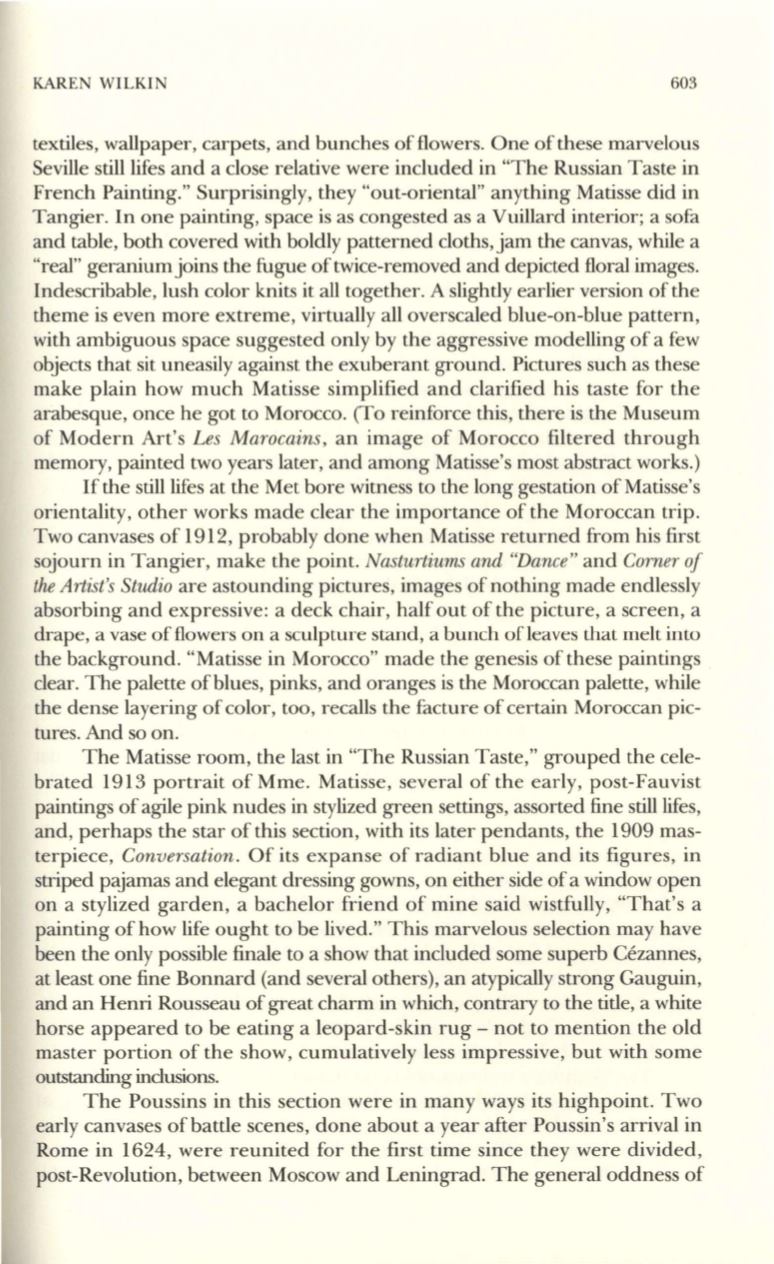
KAREN WILKIN
603
textiles, wallpaper, carpets, and bunches of flowers. One of these marvelous
Seville stilllifes and a close relative were included in "The Russian Taste in
French Painting." Surprisingly, they "out-oriental" anything Matisse did in
Tangier. In one painting, space is as congested as a Vuiliard interior; a sofa
and table, both covered with boldly patterned cloths,jam the canvas, while a
"real" geranium joins the fugue of twice-removed and depicted floral images.
Indescribable, lush color knits it all together. A slightly earlier version of the
theme is even more extreme, virtually all overscaled blue-on-blue pattern,
with ambiguous space suggested only by the aggressive modelling of a few
objects that sit uneasily against the exuberant ground. Pictures such as these
make plain how much Matisse simplified and clarified his taste for the
arabesque, once he got to Morocco. (To reinforce this, there is the Museum
of Modern Art's
Les Marocains,
an image of Morocco filtered through
memory, painted two years later, and among Matisse's most abstract works.)
If the stili lifes at the Met bore witness to the long gestation ofMatisse's
orientality, other works made clear the importance of the Moroccan trip.
Two canvases of 1912, probably done when Matisse returned from his first
sojourn in Tangier, make the point.
Nasturtiums and "Dance"
and
Corner of
the
Artist's Studio
are astounding pictures, images of nothing made endlessly
absorbing and expressive: a deck chair, half out of the picture, a screen, a
drape, a vase of flowers on a sculpture stand, a bunch of leaves that melt into
the background. "Matisse in Morocco" made the genesis of these paintings
clear. The palette of blues, pinks, and oranges is the Moroccan palette, while
the dense layering of color, too, recalls the facture of certain Moroccan pic–
tures. And so on.
The Matisse room, the last in "The Russian Taste," grouped the cele–
brated 1913 portrait of Mme. Matisse, several of the early, post-Fauvist
paintings of agile pink nudes in stylized green settings, assorted fine stilllifes,
and, perhaps the star of this section, with its later pendants, the 1909 mas–
terpiece,
Conversation.
Of its expanse of radiant blue and its figures, in
striped pajamas and elegant dressing gowns, on either side of a window open
on a stylized garden, a bachelor friend of mine said wistfully, "That's a
painting of how life ought to be lived." This marvelous selection may have
been the only possible finale to a show that included some superb Cezannes,
at least one fine Bonnard (and several others), an atypically strong Gauguin,
and an Henri Rousseau of great charm in which, contrary to the title, a white
horse appeared to be eating a leopard-skin rug - not to mention the old
master portion of the show, cumulatively less impressive, but with some
outstanding inclusions.
The Poussins in this section were in many ways its highpoint. Two
early canvases of battle scenes, done about a year after Poussin's arrival in
Rome in 1624, were reunited for the first time since they were divided,
post-Revolution, between Moscow and Leningrad. The general oddness of


